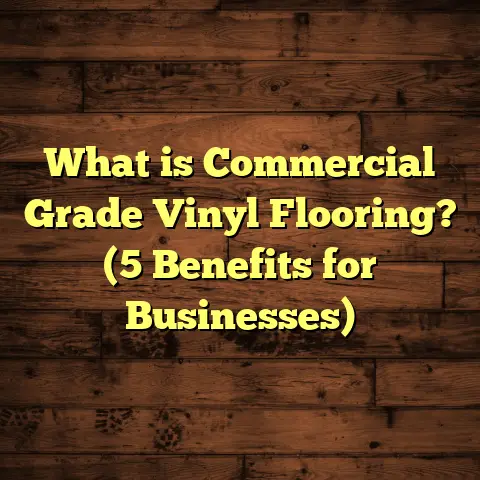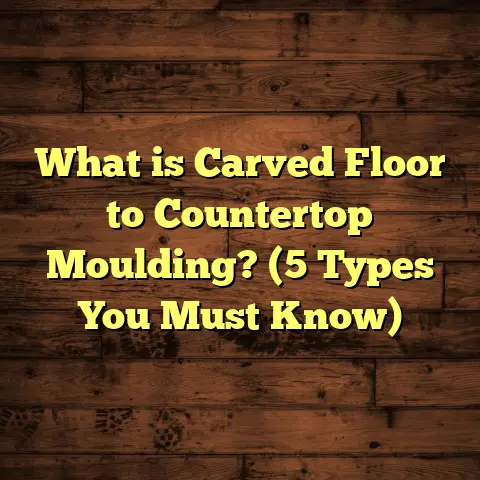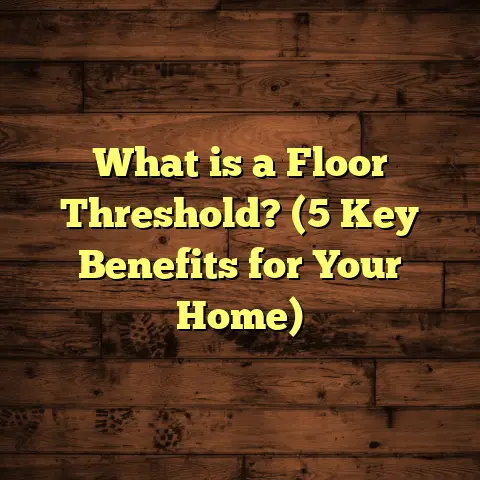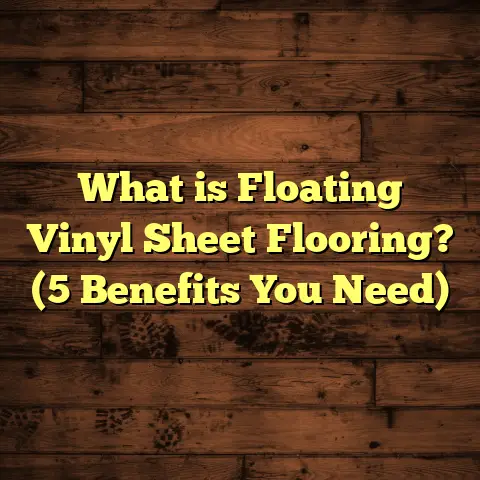What is Vinyl vs. Laminate Plank Flooring? (5 Key Differences!)
Have you ever been stuck trying to decide which flooring to pick for your home or a renovation project? I know the feeling all too well. I remember one time when I was helping a client choose flooring for their family room. They were torn between vinyl plank and laminate plank flooring. Both looked fantastic, but which one would stand up to their busy household with kids, pets, and occasional spills? That question launched me into a deep exploration of the two materials, and today I want to share everything I’ve learned about vinyl vs. laminate plank flooring through years of hands-on experience and research.
You might have heard these terms thrown around a lot, but what exactly are they? How are they made? What makes them different beyond just the look? And most importantly, which one is right for your lifestyle and budget? Let’s tackle these questions step-by-step. By the end, you’ll have a clear understanding of both vinyl and laminate plank flooring so you can make the best choice without regrets.
What Is Vinyl Plank Flooring?
Let’s start with vinyl plank flooring. What is it exactly?
Vinyl plank flooring is a synthetic floor covering designed to replicate the appearance of hardwood planks but made primarily from polyvinyl chloride (PVC) plastic. It’s part of a broader category called luxury vinyl flooring (LVF), which includes both vinyl planks and vinyl tiles. Vinyl planks are shaped like wood boards, typically ranging from 4 to 8 inches wide and 36 to 48 inches long.
Manufacturing Process and Technical Specs
Vinyl plank flooring is manufactured through a layered construction process:
- Wear Layer: The topmost layer is a clear, durable coating made from urethane or aluminum oxide. This wear layer provides resistance to scratches, scuffs, stains, and general wear and tear. Thickness varies from about 6 mil (0.006 inches) in residential-grade products to 20 mil or more in commercial-grade options. The thicker the wear layer, the more durable the floor.
- Design Layer: Beneath the wear layer is a high-resolution photographic film printed with realistic wood grain textures, stone patterns, or other designs. This layer gives vinyl its authentic look.
- Core Layer: The core can vary depending on the type of vinyl plank:
- Flexible PVC Core: Traditional vinyl planks have flexible cores that make them softer underfoot.
- Rigid Core (WPC or SPC): Newer technologies use Wood Plastic Composite (WPC) or Stone Plastic Composite (SPC) cores. These offer improved stability, durability, and water resistance.
- Backing Layer: The bottom layer adds balance and moisture resistance. It sometimes includes an attached underlayment for sound absorption.
The manufacturing typically involves calendering (rolling heated PVC layers into sheets) or extrusion processes where molten PVC is forced through molds to create precise thicknesses and textures.
Why I Like Vinyl Plank Flooring
I’ve installed vinyl planks in homes ranging from small apartments to large family houses. From personal experience, one thing stands out—vinyl’s resilience against water damage. Unlike wood or laminate, it doesn’t swell or warp when exposed to spills or humidity. I recall a kitchen renovation where the homeowners had suffered multiple water leaks before switching to vinyl planks. Since installation three years ago, they’ve had zero issues with warping or staining.
Vinyl also tends to be quieter and softer underfoot compared to laminate, which makes it comfortable for kitchens or play areas where you’re standing or walking a lot.
What Is Laminate Plank Flooring?
Now let’s talk about laminate plank flooring. What sets it apart?
Laminate flooring is also a synthetic product designed to resemble hardwood but constructed differently from vinyl. It consists of multiple layers fused together under high pressure with resins and heat.
Layers and Manufacturing
Typical laminate plank construction includes:
- Wear Layer: The top layer is made from melamine resin and aluminum oxide particles for scratch resistance. This layer protects against daily wear but can chip under heavy impact.
- Decorative Layer: Below the wear layer is a high-quality photographic paper printed with wood grain images. This paper has advanced printing that creates realistic wood visuals.
- Core Layer: The core consists of high-density fiberboard (HDF), made by compressing wood fibers with resins at high temperature and pressure. This core gives laminate its rigidity and strength but also makes it more vulnerable to water damage if not sealed properly.
- Backing Layer: A balancing layer on the back stabilizes the plank to prevent warping caused by moisture changes.
The manufacturing process involves pressing these layers together using high heat and pressure until they form a dense, durable plank with a smooth surface ready for installation.
What I’ve Noticed About Laminate Floors
From my years installing laminate floors in living rooms, bedrooms, and even some offices, I’ve noticed the solid feel underfoot that many homeowners appreciate. Laminate often feels more like real wood when you walk across it because of that sturdy HDF core.
That said, I always caution clients about moisture issues. I’ve seen laminate floors swell and buckle after water leaks because the core absorbs moisture quickly if exposed.
1. Water Resistance: Which Floor Can Handle Moisture Better?
Here’s where vinyl and laminate really start to diverge.
Vinyl plank flooring is almost completely waterproof due to its plastic composition. The PVC core doesn’t absorb water at all. If water spills on vinyl, it stays on the surface until wiped away. This makes vinyl ideal for bathrooms, kitchens, basements, laundry rooms—anywhere moisture might be an issue.
In fact, some rigid core vinyl planks have enhanced locking mechanisms that seal seams tightly against water intrusion, allowing installation even in flood-prone areas.
Laminate flooring isn’t waterproof because its core is made from wood fibers compressed into HDF. When water seeps into seams or cracks, it can cause swelling, warping, or delamination over time. Some manufacturers have created water-resistant laminates by sealing edges or adding moisture barriers, but these still don’t match vinyl’s waterproof capabilities.
Data-Backed Moisture Resistance
According to industry tests by the Resilient Floor Covering Institute (RFCI):
- Vinyl plank flooring typically scores above 90% on moisture resistance ratings.
- Laminate flooring scores less than 15% under standard moisture exposure tests.
To put it simply: if your space has any chance of getting wet regularly or humidity levels fluctuate heavily (like basements), vinyl is the safer choice.
My Experience With Water Resistance
I once helped a client who installed laminate in their basement without proper vapor barriers underneath. After heavy rains flooded their area temporarily, several boards swelled and had to be replaced—costly and frustrating. On another job with vinyl planks in a similar basement setting, we saw zero damage even after months of high humidity.
2. Installation: Which Floor Is Easier to Lay Down?
I’ve installed thousands of square feet of both vinyl and laminate floors over the years—here’s what I can tell you about installation differences:
Vinyl Installation Styles
Vinyl planks come in several installation types:
- Click-Lock/Float: Planks snap together edge-to-edge without glue or nails onto a flat subfloor.
- Glue-Down: Adhesive applied directly to subfloor; planks pressed into place.
- Loose Lay: Planks rely on friction and weight to stay put; sometimes combined with an underlayment.
- Peel-and-Stick: Adhesive backing on each plank; good for quick DIY but less durable long-term.
Click-lock vinyl has become very popular because it’s easier for DIYers and contractors alike—no messy glue needed, and you can install over existing floors in many cases.
Laminate Installation
Laminate floors almost always use a click-lock floating method as well but require an underlayment beneath for sound absorption and moisture protection.
Laminate needs a very flat subfloor because its rigid HDF core doesn’t flex much. Any bumps or imperfections can cause gaps or damage over time.
DIY Friendliness
If you’re thinking about doing it yourself, both vinyl click-lock planks and laminate floors are manageable if you’re comfortable with basic tools like a saw and spacers.
From personal experience helping friends lay both types:
- Vinyl click-lock planks sometimes forgive small subfloor imperfections better because of their slightly flexible core.
- Laminate requires more precision in leveling but locks firmly once installed.
For large rooms or uneven subfloors, professionals often recommend leveling compounds before laminate installation.
3. Durability: Which One Will Last Longer?
Durability depends on how much wear and tear your floor will face daily.
Vinyl’s Durability Profile
Vinyl’s wear layer thickness plays a major role in durability:
- Residential-grade vinyl usually has wear layers between 6 mil (light traffic) to 12 mil (heavy traffic).
- Commercial-grade vinyl can have wear layers up to 20 mil thick.
Thicker wear layers resist scratches better and prolong floor life.
Vinyl floors also flex slightly under impact rather than cracking or chipping. This makes them ideal for households with kids, pets, or moving furniture frequently.
Laminate Durability
Laminate floors get their durability rating through AC classes (abrasion classes):
- AC1: Light residential use
- AC2: Moderate residential use
- AC3: Heavy residential/light commercial use
- AC4/AC5: Commercial-grade use
Most home laminates are AC3 rated, meaning they handle daily foot traffic well but may chip if something heavy falls on them.
Laminate surfaces resist scratches well thanks to melamine resin but are brittle compared to vinyl.
Real-Life Case Studies
In one project I managed at a community center with heavy foot traffic:
- Vinyl planks with 20 mil wear layers lasted over five years without refinishing.
- Laminate floors in nearby offices showed wear patterns after just two years due to dents and chips from dropped objects.
In another client’s home with dogs:
- Vinyl resisted claw scratches better.
- Laminate showed some surface marks but remained intact otherwise.
4. Appearance & Texture: Which Feels More Like Real Wood?
Both vinyl and laminate have made huge strides in mimicking hardwood appearance thanks to advanced printing technology and embossing techniques.
Visual Realism
Vinyl uses high-resolution photographic films combined with embossed textures on the surface that replicate wood grain patterns and knots impressively well. Luxury vinyl planks (LVP) especially capture intricate details such as pores and distressed finishes.
Laminate uses high-quality printed papers pressed into the melamine resin top layer with embossing that often results in sharper texture definition than vinyl.
Texture & Underfoot Feel
Vinyl tends to feel softer due to its plastic core and slightly cushioned backing layers. This softness reduces noise from footsteps and feels warmer in cold environments.
Laminate feels harder and more solid because of its dense fiberboard core—closer to traditional wood flooring in terms of rigidity but less forgiving on impact.
Personal Preferences I’ve Seen
Clients who want formal living spaces often prefer laminate for its hard feel and sharper textures that mimic hardwood closely.
Those wanting comfort underfoot in kitchens or playrooms lean toward vinyl’s softer touch.
I once installed both types side-by-side in a showroom so clients could feel the difference firsthand—it was amazing how distinct they felt despite similar looks!
5. Cost Comparison: Which Flooring Gives You More Bang for Your Buck?
Budgeting for flooring can be tricky because cost varies widely depending on quality, brand, style, and installation method.
Material Costs
Average retail prices per square foot:
| Flooring Type | Price Range |
|---|---|
| Vinyl Plank | $2 – $7 |
| Laminate Plank | $1.50 – $5 |
You can find entry-level laminates cheaper than some high-end luxury vinyls but remember prices fluctuate based on thickness and features like waterproof cores or enhanced textures.
Installation Costs
Professional installation typically adds $1.50 to $3 per square foot for both types depending on region and floor complexity.
DIY installation saves money but requires time and skill.
Long-Term Value
While laminate usually costs less upfront, vinyl’s longer lifespan in wet areas often means fewer repairs or replacements over time—translating into savings down the road.
A client I recently worked with switched from laminate to vinyl for their bathroom remodel after I showed them projected costs over 10 years including potential water damage repairs. That decision saved them almost $5000 in maintenance alone on a 500 sq ft space.
Additional Insights From My Research & Experience
Environmental Impact & Sustainability
Both floors are synthetic products relying on plastics or wood composites but have different environmental footprints:
- Vinyl production involves PVC which releases harmful chemicals if not managed properly.
- Laminate uses wood fibers but resins involved aren’t biodegradable either.
Recycling programs exist for both materials but are limited—something worth thinking about if sustainability matters to you.
Maintenance & Cleaning Tips
Vinyl is very low maintenance—regular sweeping and occasional damp mopping keep it looking great without harsh chemicals.
Laminate requires careful cleaning—avoid soaking it with water; use manufacturer-approved cleaners to prevent damage.
I always recommend placing felt pads under furniture legs on either floor type to prevent scratches.
Common Questions I Get Asked About Vinyl vs Laminate Flooring
Q: Can I install vinyl over laminate?
A: Yes! Vinyl click-lock planks can often be floated right over existing laminate floors if they’re flat and stable—saving demo time.
Q: Which floor is better for radiant heating?
A: Both work well; however, vinyl’s flexibility often handles temperature changes better without cracking.
Q: Are there toxic fumes from vinyl?
A: Modern products meet strict VOC standards; however, airing out new vinyl floors before full occupancy is recommended if you’re sensitive.
Final Thoughts From My Years On The Job
Choosing between vinyl plank flooring and laminate plank flooring comes down to weighing factors like moisture exposure, budget, installation preferences, durability needs, and desired aesthetics. Both have strong points:
- Vinyl excels where moisture resistance and comfort matter most.
- Laminate shines when visual realism and hardness underfoot are priorities.
When I advise clients personally, I ask about lifestyle habits (pets? kids?), room function, subfloor condition, budget limits—and then help them test samples side-by-side. That hands-on approach ensures they pick a floor that not only looks great but performs well for years to come.
If you’re ready to take the next step—whether it’s calculating costs using tools like FloorTally or exploring specific brands—I’m here to help guide you through it all.
So tell me—what kind of space are you thinking about upgrading? Maybe we can figure out together which plank flooring fits your needs best!





